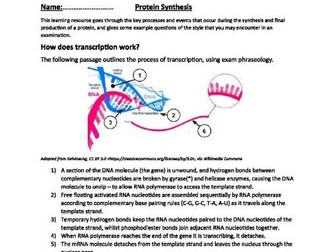Protein Synthesis
<p>Protein Synthesis questions relating to theTranscription, Translation and Protein Synthesis topics of OCR A Level Biology.</p>
<p>10 questions, 27 marks.</p>
<p>A resource pack conssiting of a 6 page guide to transcription, translation and protein synthesis. Including an overview of how transcription and translation works broken into steps written in the style of the exam board, why transcription is important in the context of protein synthesis and DNA, the nature of genetic code, comparing the structure or DNA and RNA, as well as the different types of RNA and their roles and an overview of the key cellular components involved in protein synthesis and their roles,</p>
<p>Also including a 4 page practice question booklet consisting of a mixture of recall, identify, describe, compare, explain, short answer, long answer and simple calculation questions. Written in a style mimicking the official exam board to maximise the value of practice.</p>
<p>Content of the Questions provided includes calculating how many bases are needed to code for a polypeptide chain, why transcription is important, describing the role of cellular structures relating to protein synthesis and identifying them on diagrams, comparing DNA replication and protein synthesis and comparing the structure of DNA and RNA.</p>
<p>Mark scheme provided.</p>






